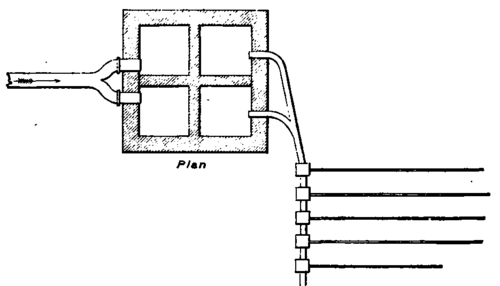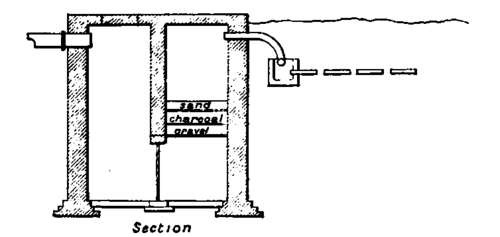Water Closets And Soil Pipes
Description
This section is from the "Practical Building Construction" book, by John Parnell Allen. Also see Amazon: Practical Building Construction.
Water Closets And Soil Pipes
Every water-closet apparatus, on whatever principle, whether valve, wash-down, or wash-out, should have the following properties, to secure safety:-
1. Simplicity in its working parts.
2. A proper trap in connection with it; having a seal of not less than 1 3/4 inches (many have but half this).
3. A sufficient depth of water in the basin to cover the excreta, and so suppress bad smells.
4. Such means of connection to a soil pipe as will ensure a perfect, permanent, and secure joint - a point which also applies to the ventilation horn of the trap.
5. A flushing arrangement that will allow of a flush of from 2 1/2 to 3 gallons of water, to completely change the body of water contained in the basin and trap, and carry the excreta and paper to the farthest possible distance.

Fig. 1001.

6. It should have no dry surface exposed to contamination.
All closets having these qualities may be considered - to be appliances that will meet all usual requirements, and they are connected to the drain below by a soil pipe of glass-enamelled or coated cast iron, or lead (the latter being the most lasting substance when properly fixed); and such pipes should, in all cases, be always fixed outside, and carried up full bore to the ridge of the roof, terminating at a position remote from all windows or openings into the house, and away from any projection likely to cause a back draught in the pipe.
There is a diversity of opinion as to the size of these soil pipes, some sanitarians requiring 4 inches diameter for each closet, while others are satisfied with a 2 1/2 -inch pipe for a stack of three closets; the writer's opinion being that if the pipe be large enough to carry away the solid matter deposited in the basin, the smaller size undoubtedly offers the greater certainty of being kept clean.
Where the branch piece between the outlet of the apparatus and the stack outside is of any considerable length, the trap should be ventilated separately, as also in cases where more closets are fixed on one stack, when each trap should be separately ventilated by a pipe carried up to a position higher than the upper apparatus, and then branched into the main vent pipe - precautions which are absolutely necessary to prevent syphonic action unsealing the traps by removing the pressure at one side of the water seal; and many cases have occurred in which ignorance of this important matter has been the cause of an escape of sewer gas into a dwelling.
Where lead soil pipes are connected to iron or stoneware, a brass ferrule should be wiped on to the end, to allow of a properly caulked joint being made; and all soil pipe joints should be made perfectly air-and water-tight, besides which it is sometimes advisable to treat soil pipes locally, and disconnect them from the house drain or sewer by a trap at the foot, ventilated separately, as Fig. 1002, which reduces the risk of sewer gas, in case of any defects to internal fittings; and where this is done, of course a separate ventilating pipe is required for the drains, irrespective of the soil pipes.
Continue to:


